Teaching students is no easy task. Educators face numerous problems every day, including the difficult decision of which techniques, strategies, and teaching methods to use with their students!
How can a teacher manage these and other issues?
We have the answers! IvyPanda developed a teaching guide that contains all the information you need, from basic teaching principles and strategies to useful tools that will come in handy for most educators.
👩🏫 What is education and teaching?
Before we dive into the details of teaching, let’s clarify the difference between education and teaching!
Teaching and education are similar ideas but each has a specific, independent meaning.
Education has had a significant impact on society. It involves the transmission of values and knowledge from adults to children. The quality of education depends on the society. In underdeveloped cultures, children receive little or no formal training. However, in most developed countries, schooling is mandatory for all children.
When we talk about teaching, we mean the process of educating. Actually, teaching can be described as an instrument for learning. These two terms—teaching and education—are difficult to separate since they’re interwoven into the same process.
🎓 7 Principles of Teaching
If you’re going to pursue a teaching degree, then you should read Chickering and Gamson’s article “Seven Principles for Good Practice in Undergraduate Education.” In this article, the authors describe teaching guidelines that work for all students regardless of their nationality, age, or economic background.
Even though the principles were written more than 30 years ago, they’re still applicable to any type of learning. Here they are:
Inspire contacts between teaching faculty and students.
A strong connection between teacher and student is crucial for a student’s success. Students need feedback and support from their pedagogues. Let’s see how this principle can be implemented in the classroom as an effective teaching method:
- Names. To establish good relationships with students, a teacher should learn their names. We think you will agree that calling students by their names creates an environment of trust. When you know your students’ names, you show them that you care about them.
- Extracurricular activities and student events. Out-of-classroom activities, like sports, excursions, or even formal events play a significant role in student success and team building. According to the National Center for Educational Statistics, students who actively participate in extracurricular activities perform better than those who don’t.
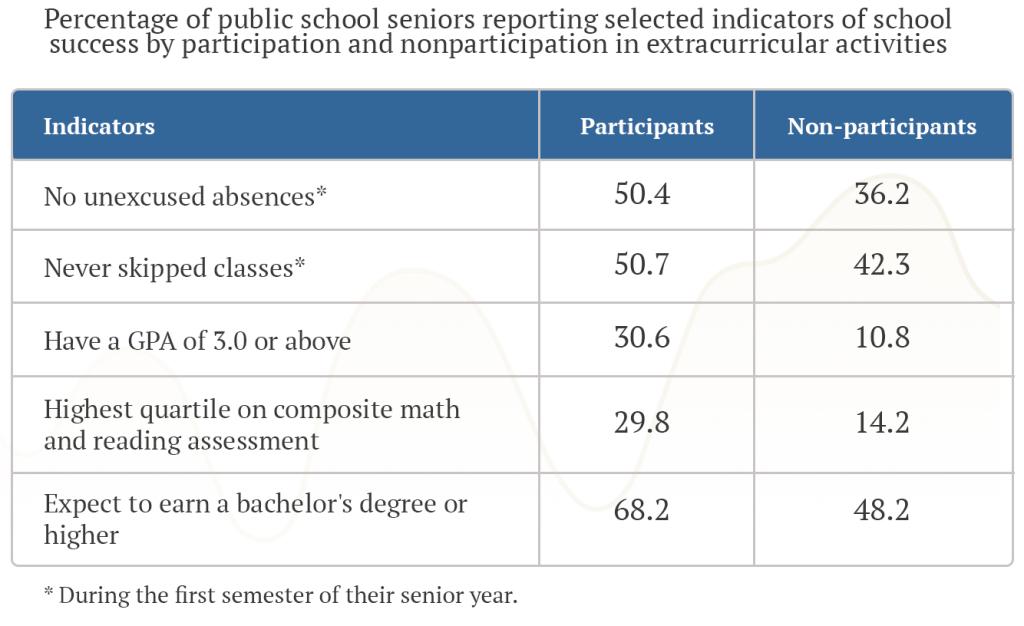
As a teacher, developing a strong sense of connection allows you to learn more about your students’ personalities and goals. You’ll also be able to share your values, teaching skills, and experience more comfortably with your students.
- Regular analysis and feedback on students’ outcomes. By providing personalized feedback on assignments, you help your students gain self-awareness, confidence, and eagerness to continue learning.But only giving feedback on assignments is not enough. You should also ask for inverse feedback at the end of each class. You will get an understanding of how well students are learning the material you provide and will be able to adjust your teaching program or work with students who have problems in your course.
- Work with students on a personal level. As a teacher, you can encourage students through individual conversations, which offer the opportunity to learn about their educational and career aims and even connect them with your colleagues.
- Active student involvement in class discussions. When you involve your students in verbal activities, like debates, discussions, etc., you teach them to express their thoughts through verbalization.
All of these examples can be adjusted for distance learning. For example, in-class discussions can be replaced by group chats on Facebook or emails.
Enhance students’ cooperation
Group work positively affects the development of critical thinking, communication, and persuasive skills. Working in groups, students learn to collaborate with others as they will have to do in their future.
Check out these ideas on how to implement this principle in the teaching process:
- Peer tutoring. Numerous research studies of peer tutoring show that students who participate in the role of tutor have higher achievement than those who don’t. Also, researchers found that same-age tutors are as useful as older ones.
- Exam preparation and group assignments. Research shows that students who prepare for exams and assignments in groups experience less exam anxiety. Group work increases their comprehension of the information.
- Campus clubs and organizations. As a teacher, you should encourage your students to join clubs and organizations at their schools or universities. By joining a club, students are presented with networking and social opportunities. Many campus organizations host various career events with the participation of industry leaders. Attending such events allows students to establish professional connections that could be helpful in their future careers.
Engage Students in Active Learning

If you take a look at the Eastern education system, you will see that their students participate passively in the learning process. Often, they sit and listen to their professor without asking questions or debating the lesson topic.
The western education system, in contrast, is more active, and includes discussions, writing assignments describing what students have learned, and the application of academic lessons to students’ daily lives.
Below, we will discuss various teaching strategies in detail.
Keep reading!
Give a Feedback
From the very beginning of their studies, students need feedback on their performance. As a teacher, you should evaluate their knowledge and offer methods for improvement. Through the teacher’s feedback, students learn how to assess themselves and determine how to advance in their studies:
- Discuss the general outcomes and common mistakes of assignments and exams. Avoid discussing an individual’s error in front of the class. You can dedicate time for a personal consultation to explain the error and provide suggestions for improvement.
- Use various assessment formats. For example, you can use software solutions for testing, quizzes, papers, etc. (Students who regularly receive quizzes show better results on standardized tests.)
- Implement Q&A sessions. While answering questions regarding course material, you can ask students to model a similar issue to the one just examined, to compare two contrasting issues, etc. Engaging in critical thinking will help students better understand the learning material.
Point out the Importance of Time Management
Time management is important for both teachers and students. Setting realistic deadlines for assignments helps students control their procrastination. Avoid assigning ten papers in nine weeks, for example.
Here is some advice on how you can help your students meet deadlines:
- Set clear and realistic deadlines for assignments. Explain to your students how much time they should dedicate to complete the tasks.
- Meet with students who fall behind. As a teacher, you should discuss the student’s schedule, study habits, and, if applicable, explain why they shouldn’t skip classes.
- Use technology in class. There are lots of useful tools for teachers that help encourage students to finish their assignments on time. Don’t rely only on old-fashioned methods.
Here’s the thing:
It may seem like the more time a student spends on studying, the more successful they’ll be. However, there’s a huge difference between the amount of time spent and its quality. Some students require very little time to complete an assignment and prepare a wonderful persuasive speech. Others may spend a lot of time procrastinating. Your task is to manage the student’s desire to learn and help them to deal with procrastination.

Point out High Students Performance Expectations
Here’s the deal:
The more you expect—the more you get. When a teacher has high expectations for their students, regardless of their motivation or knowledge level, they positively impact the students’ performance. Check out these ideas on how to encourage your students:
- Individual work. Dedicate more time for individual work with students who are at risk of failing your subject, providing additional guidance and motivation. By the way, you may find Claude Goldenberg’s article“The Limits of Expectations: A Case for Case Knowledge About Teacher Expectancy Effects” interesting and helpful in this regard.
- Strict deadlines and guidelines. We already mentioned that setting clear and realistic timeframes for students is necessary. You also need to give them a meticulous syllabus where you point out the upcoming assignments, methods of grading, and due dates.
- Acknowledge high student performance. Every student works at their own pace and level. Some may acquire information quickly and easily complete all assignments, while others may work more slowly. Your task is to explain that everyone should strive for their best individual performance possible, focusing on the acquisition of knowledge instead of grades. And don’t forget to regularly update the course content, so students remain challenged.
Respect diverse learning styles

There are no two people whose learning styles are completely identical. Some students perform better in speeches and debates, while others excel in the lab, for example. A teacher should allow students to express themselves and learn in ways that work best for each individual. Here are some examples:
- Online technologies use. There are plenty of web tools and apps that allow students to choose the studying experiences that perfectly fit their learning styles: quizzes, tests, tests prepare apps, and more! Just imagine: in 2017, the global smart education and learning market was valued at $135.5 billion!
- Extra materials and readings. Your students may come from very diverse backgrounds and may have different levels of knowledge. As a teacher, you should provide additional materials for those who lack fundamental knowledge. One such resource could be an essays database containing examples of works students are going to have to be dealing with.
- Diverse teaching activities. Field trips can be important opportunities to show students the day-to-day activities of their potential future careers. Open-ended questions, which ask your students to solve problems that have multiple solutions, can be great themes for discussions and debates. Also, we recommend taking a look at Howard Garder’s research studies on the theory of multiple intelligences.
Implementing these teaching principles in your daily work as a teacher will benefit your students and help them achieve success.
💢 Common Problems Teachers Face and How to Deal with them
Teaching is a profession that inspires students to become a better version of them. However, the teacher’s life is not only about grateful students who succeed in their careers.
Like other professions, teachers may face lots of challenges. Below, we will describe the most common issues that bother teachers and share some ideas on how to address them.
Lack of Time for Planning and Paperwork Overload
Teachers are great managers. Nowadays, they have a lot of tasks that require planning and time-management.
So, here’s a small part of what an average teacher should plan and control:
- Syllabus. Educators do not just finish it once and forever. They update course content and study materials to new market demands.
- Field trips. Even a short trip to the nearest museum or company requires lots of time to plan it in detail and foresee all possible circumstances.
- Extracurricular activities. Many teachers actively participate in school and university clubs, career fairs, etc.
As you can see, teachers have to handle multiple activities and roles.
But…
The biggest problem of these roles is the lack of time. Planning, preparation, and performance of tasks add a lot of pressure and even can cause teacher burnout.

Another significant contributor to the burnout is never-ending paperwork. Teachers not only have to prepare high-quality teaching content, but also act as social workers, counselors, and more!
They have regularly update student statistics and growth indicators in addition to lesson plans and other teaching notes. By the way, have we already mentioned how much time takes the feedback on students’ assignments? Such extensive paperwork can negatively impact the quality of teacher performance and work-life balance.
How to deal?
Digitalize! There are a lot of useful tools that teachers can use in their work. Software solutions allow them to plan, reduce paperwork, share materials with colleagues and students, track the deadlines, etc.
Most modern planners and organizers allow to collaborate with others; add notes, links, and files; comment; set reminders, and stay flexible.
But digitalization only itself can’t save you from routine and multiple tasks. A teacher has to have excellent time management skills to keep the work-life balance. In IvyPanda article “51 Best Free Study Apps for College Students: Ultimate List,” you can find tools that come in handy even in teacher’s daily work.
Balancing Diverse Learning Needs
All students in a class are different and have diverse learning styles. As a teacher, you should find a personal approach to your scholars to succeed in your subject. However, satisfying ALL learning needs of EVERY student can be a challenging task. Especially when there are 30+ students in a class.
But…
There are a lot of various teaching strategies that can be successfully implemented in every class. Even though all of them require additional time for preparation, once you learn them, your students will benefit.
How to deal?
First, provide an in-depth analysis of the most common learning styles in your class to determine the different types of learners among your students. Study and analyze different teaching approaches that work best for them. Adapt your lesson plans according to these strategies.
In our article, IvyPanda experts will give you the essential information you may use for further research. Later, we will discuss the seven most common learning styles and diverse teaching strategies.
Keep reading!
Lack of Students’ Motivation

Unfortunately, not all students in the classroom are motivated and respectful. Even if you are the best teacher in the world and prepared exciting lesson materials, it would be useless if your students don’t have intrinsic and extrinsic motivation.
Moreover, as a teacher, you should always be aware of what and how you’re saying or doing something as it can be used against you. And you still have to teach even amidst an unfriendly atmosphere or silent classroom.
Sounds hopeless, huh?
How to deal?
Educators have various instruments that could help motivate students and create a friendly and respectful atmosphere in the class. Among them is the involvement of the school administration and parents in the study process. Three-side cooperation “teacher-parents-student” can be a great contribution to the students’ performance and success.
Lack of Parental Support
What if parents just step away from their responsibilities? The little or no parental support can result in student’s lower grades, worse school attendance, and higher dropout rates compared to their classmates whose parents are actively participating in their school life.

Numerous studies show how parental involvement can impact students’ performance, and teachers should take initiatives to increase the role of parents in the education of their child.
How to deal?
If you think that there’s nothing you can do if parents don’t pay attention to their child, you’re wrong.
Here are the ways you can increase parental involvement:
- Communicate with parents. You should meet them in class or plan a home visit. Talk about their expectations, explain how they can track a child’s progress, and communicate with a teacher through apps. Provide recommendations for homework help.
- Invite parents to become volunteers. Active participation in school activities gives parents a clear understanding of the challenges their child may face on a daily basis.
- Use online tools. Advice videos, blogs, calendars can come in handy for parental involvement. Because of the heavy workload, parents can miss a lot of school events and have no idea what’s happening in the school. Such tools can keep them in the loop.
Changing Educational Trends

Evolving technologies are actively implemented in the curriculum and are an essential part of most of the subjects. Education institutions have to adopt new tools to keep updated to current trends.
You may say: What’s the problem with using all those technologies?
Here’s the answer:
Quite often, schools do not provide adequate training to teachers on how to work with these tools. Teachers have to figure out how they can use these tools and utilize them effectively.
Spending additional time on self-paced learning of trending tools and apps may lead to frustration and burnout.
How to deal?
Day by day, we see the technology growth. A few decades ago, people could only dream about autopilot cars, smart homes, and other solutions that aimed to improve the quality of life.
Teachers should stay on top of current trends; however, it doesn’t mean that they have to spend nights to find the perfect solutions for their classroom. Here are a couple of ideas of how to deal with the latest technology trends and implement them in the class:
- Find the sources. As technology grows, it may have a sense for educators to find the sources that provide advice on how to implement new tools in the teaching process. For example, EdSurge provides guides and weekly podcasts on current trends, tech innovations, etc. Here, at IvyPanda, you can also find useful information about the tools you can use in the classroom and recommend to your students.
- Seek school support. You can’t use technology if your school or classroom policies don’t support or even prohibit it. That’s why we recommend checking what tools your students can use.
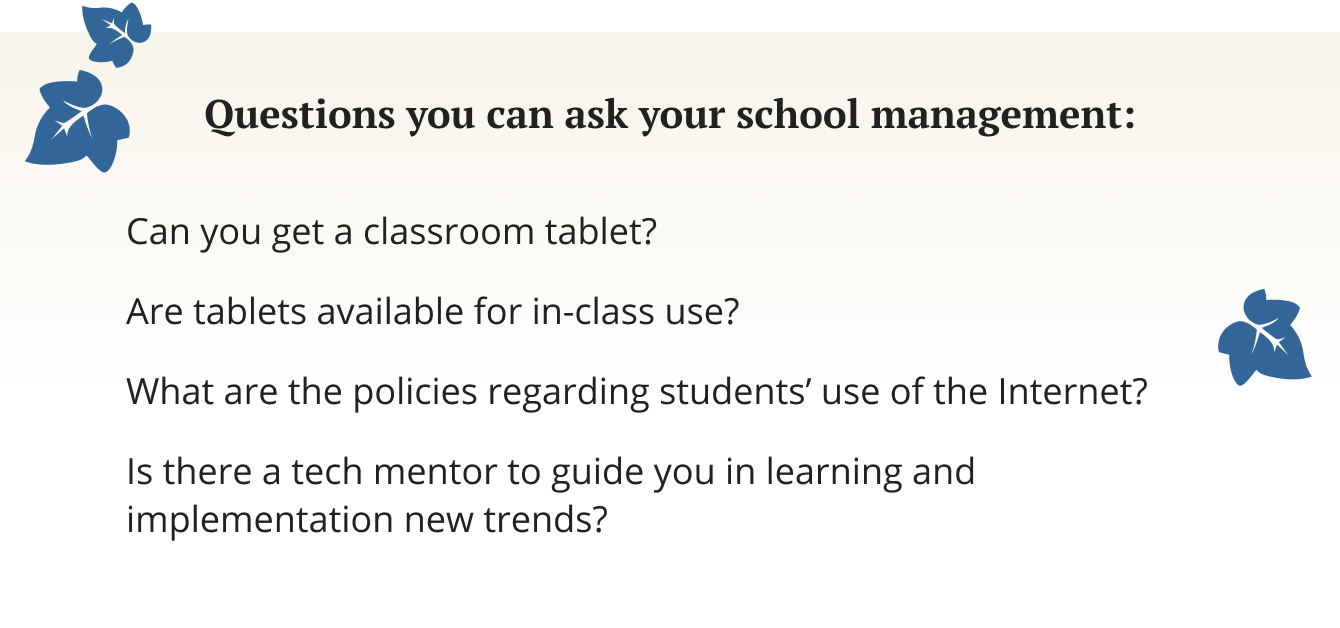
There are still teachers with low computer literacy. New teachers, at the same time, might not be aware or have only basic knowledge of the available technologies. That’s why school support and advice from a person who is more experienced in the practical use of technology in the class.
Pressure from School Administrators
Educators of all levels experience serious pressure from administrators, colleagues, and competitors. The mission of every school and college is to secure the possible high quality of education. And, as in the business, each school strives to become the best.
This phenomenon has a simple explanation: the higher quality of teaching leads to a higher enrollment rate. And, in its turn, a school gets more funding for further development. This statement is true for both public and private institutions.
In this formula, “student-funding-school development,” a teacher plays a significant role since they are responsible for students’ outcomes. And, as a result, they have to perform well while giving no reasons to blame.
How to deal:
Don’t hesitate to seek help. You can always reach out to your school administrators when you have problems with students and/or their parents. Sometimes, third-party involvement can become a solution. Standing as one front, you can develop a proper solution that will fit student’s needs.
Ask if there is a way to automate some of your routines or even dismiss some of the unnecessary reports. Don’t be afraid to argue your points and suggest ideas on how to effectively improve the system.
Teacher’s Burnout

Burnout becomes an epidemic among teachers. According to the 2017 Educator Quality of Work Life Survey, conducted by the American Federation of Teachers, 61% of teachers describe their profession as stressful. 58% of the surveyed state that their mental health was not good.
Sounds alarming, huh?
But there’s another problem among research studies. Almost none of them study the nature of burnout. You can easily find articles about causes, signs of burnout, and prevention strategies. Want to know what is truly mean of being burned-out?
Keep reading!
Irvin Sam Schonfeld and Renzo Bianchi in their research “Burnout and Depression: Two Entities or One?” state that there’s a strong connection between depression and burnout. Researchers point out that burnout is a work-caused depression. Teachers’ burnout often described as mood swings, loss of interest, and/or fatigue.
Another research, “Is burnout a depressive disorder? A reexamination with special focus on atypical depression” shows that 90% of participants who showed burnout signs met the criteria for depression. In other words, we can state that burnout is a form of depression.
The actual problem is that most recommendations in popular magazines advice burnout sufferers to engage in various social activities and take a short break at work. However, these self-help strategies do not work.
Why?
Burnout, as well as depression, is characterized by an inability to experience joy in activities that brought pleasure before, and summer vacation is an only temporary fix—symptoms return quickly.
How to deal?
Teacher burnout is a serious problem, and we shouldn’t underestimate it. Teachers need regular psychological and medical assistance to control and reduce signs of burnout symptoms.
If depressive signs are ignored, the consequences might be unintended: from ineffective teaching to suicide.
Here are the strategies that school managers and teachers may use to prevent burnout:
- Create a supportive work atmosphere. Employees must know that no one will blame them for depression or other mental health issues. As a teacher, you should not ignore your colleague, who continually complains about feeling tired and unhappy. At the same time, you must carefully listen to yourself and, if warning signs arise, contact your psychologist.

- Minimize organizational factors. Many believe that burnout is an integral part of the teaching profession. However, this statement is not true, and reducing work overload and proper time management can significantly decrease burnout cases.
- Proactively participate in school training dedicated to mental health issues. Once you learn how to recognize mental health concern, you will be able to assist someone who suffers from it and even help yourself. For example, Mental Health First Aid provides training for both youth and adults.
Now, when you are aware of the principles and pitfalls of the teaching profession, let’s return to class and find out more about the most common learning styles and training strategies to use.
📖 Learning Styles
The seventh principle of teaching says that as a teacher, you should respect your students and the ways they learn.
Below, we will describe the seven most common learning styles. However, you should remember that no human would pick up the only one style. Thus, a person can be a visual learner, but at the same time, they are logical learners too.
Visual Learning Style
Some sources also call this learning style “spatial.” Visual learners perceive information through images and graphics. This type of learning may also require writing or mapping the information learners get to process and memorize it.
So, what are the common characteristics of the visual learning style?
Visual learners enjoy drawing, coloring, and easily visualize plans, objects. They have an outstanding spatial sense and are good at using maps. In class, they better process the information by writing then just listening to the lecture.
Aural Learning Style
Aural or auditory-musical learning style usually used to determine students who better react on sounds. Aural learners have a good sense of rhythm and can’t work or study without background music.
They often use rhymes and rhythms to memorize study material. Auditory learners are skilled in presentations and verbal assignments. As a rule, they are effective storytellers and can deal with complex issues through talking.
Verbal Learning Style
Verbal or linguistic learners perform best in both writing and speaking. This type of information perception can be seen in public speaking, journalism, writing, and debating.
To process new information, verbal learners read it aloud or write it down several times.
Among typical characteristics of linguistic learners are enhanced vocabulary and passion for learning new words, tongue twisters, and rhymes.
Physical Learning Style
You might have heard about kinesthetic learners. They always need to move and to do something physically: carving, knitting, walking, dancing, etc. It may seem that they have a never-ending battery inside.
The thing is…
They learn through moves and motions. These students are excellent at sports, art, and drama, and have good motor memory.
Logical Learning Style

The logical learning style uses reasoning and analytical sequences to process information. It is often called a mathematical learning style. There are a lot of logical learners among engineers, scientists, and mathematicians.
Such students easily execute complex calculations, see patterns, and come with a solution to an issue. They are great at planning, classifying, and categorizing.
Social Learning Style
The interpersonal or social learning style best describes students who enjoy interacting with others, teamwork, and peer learning. These people can be easily found at school and college clubs, committees. The students thrive in group activities, debates, mentor-apprentice relationships.
Social learners are good at communications and may feel uncomfortable when they have to work on self-paced assignments and courses.
Solitary Learning Style
In scientific literature, you may also find the definition “Intrapersonal learning style.” Intrapersonal or solitary learners who, unlike social learners, prefer to study alone and spend their spare time away from crowds.
Most of the solitary learners are typically introverts; however, not all of them. Extroverts may choose to be alone when they study too to retain new information.
All the styles mentioned above, require a personal approach and a proper teaching strategy. It’s simply impossible to use one technique and hope that it would fit all 30 students in your classroom.
📝 Classroom Teaching Strategies
In this section, we will discuss various strategies you can use in the class. You can combine them to help you achieve high results.
Classroom Management Strategies
Poor class management can cause numerous troubles. Just imagine: students racing across the class, yelling, throw papers… Sounds awful, huh?
Needless to say that such a situation will negatively impact your mental health, increase chances of burnout, and student lesson perception will be too low to complete the course. If you think that you can do nothing with this issue, try our solutions:
- Promote ideal behavior
Remember the golden rule of relationships? Treat others as you’d like to be treated. When you demonstrate the class the perfect behavior you want to see, it works more effectively than if you try to yell at students.
Simple rules like using polite language, keeping eye contact, avoiding interruption other’s speech, etc., can work effectively in teaching students.
- Involve students in creating class rules
The best way to create a friendly environment in the class is to ask students what they find acceptable and not acceptable. For example, you can discuss whether using phones during the lecture is okay or not. Such discussion supports mutual understanding and respectful student-teacher relationships.
- Document class agreements
As you print out the syllabus, document, and print out the result of the class discussion, we talked in the previous paragraph. Go through the list with pupils again—you will show that you respect their points of view. At the same time, it will be easier to refer to this doc in case of violation of the rules.
Moreover, you can create an exciting student handbook or guide where you put the class rules, important events, curriculum information, etc.
- Don’t punish the class
During your teaching career, you’ll meet very different students. They won’t listen to you and will check your limits: how far they can go in disrupting lessons and fooling around.
Don’t punish the class because of such students. Instead, you should call out specific students and address their behavior. Doing so, you will stay friendly while acknowledging bad behavior.
- Promote students’ initiative
Allow your students to get ahead in studies from time to time. There always will be a few eager students in your class. Don’t hesitate them if they want to read the next chapters in a textbook you’re reading or prepare an extended presentation on the upcoming lesson subject. This strategy will be beneficial for both types of students: those who will do their small research and those who don’t. “Lazy” students will also want to work more when they see that study can be exciting.
- Praise students who perform well
Praising students inspires them and motivates other pupils to do the same. Research studies prove that praise students improve their academic performance and positively impact their behavior.
Here’s an example: your student demonstrates outstanding problem-solving skills when tackling a tough math task. When you praise this student, you motivate them to use this tactic in the future. Moreover, you encourage others to work hard too.
- Don’t underestimate the importance of non-verbal communication
Visualization can be a great add-on to the lecture. Visual aids like infographics, videos, running learning stations allow you to deliver various content and students to process the information easier.
- Party!
Classroom parties are fun. But have you ever thought that it could be a motivator for your students? Use parties as an acknowledgment tool to praise the class’s hard work.
Explain that a party is a reward, and students can earn it in the future if they score high on an assessment, demonstrate perfect behavior, etc.
There are many more classroom management strategies you can use in the class to ensure good students’ performance and behavior. You can combine those we mentioned, search for best practices, or develop your own.
Flexible Seating

Despite the numerous research studies that prove the positive effect of flexible seating, there is still a lot of skepticism around it.
Here’s the deal: when students are required to sit still and quiet in their chairs, they concentrate more on holding themselves instead of the perception of the information.
If you still doubt whether your students need flexible seating, check the arguments of how beneficial it can be:
- Positive impact on physical health.
Children (and adults) need to move. Constant seating at the table in the inconvenient pose adverse affects their posture and backbone. At the same time, flexible seating allows students to move, bounce, rock, or stand. This increases the oxygen levels in the brain and keeps students’ minds more focused.
Studies show that physical in-class activities boost students’ performance and engagement.
- Students are able to make their own choice.
Flexible seating allows students to control their environment and comfort. This is extremely important when you work with younger pupils or students with special needs. Giving students a choice, you teach them “higher-order thinking skills,” says Kayla Delzer, the author of “Why the 21st-Century Classroom May Remind You of Starbucks.”
As for the students with ADD/ADHD and ASD, flexible seating options are helpful as they stimulate a sense of touch.
- Students collaborate and communicate easier.
Flexible seating gives students the opportunity to choose their space and share it with others. Also, it will be more beneficial when pupils have to work in small groups because they don’t need to move heavy desks for eye contact.
Webb’s Depth of Knowledge
You might be aware of Norman Webb’s Depth of Knowledge theory. In short, this theory divides contexts (challenges, scenarios, and prompts) into four levels.
The key idea of the theory is that students go through levels and face contests that require deeper learning and thinking:
Level 1: Recollection and Reproduction
This level requires students to remember and recall formulas, terms, and facts. Students don’t have to solve any problem. So, you should base the assessment on asking specific questions to find out whether a student knows the answer or not.
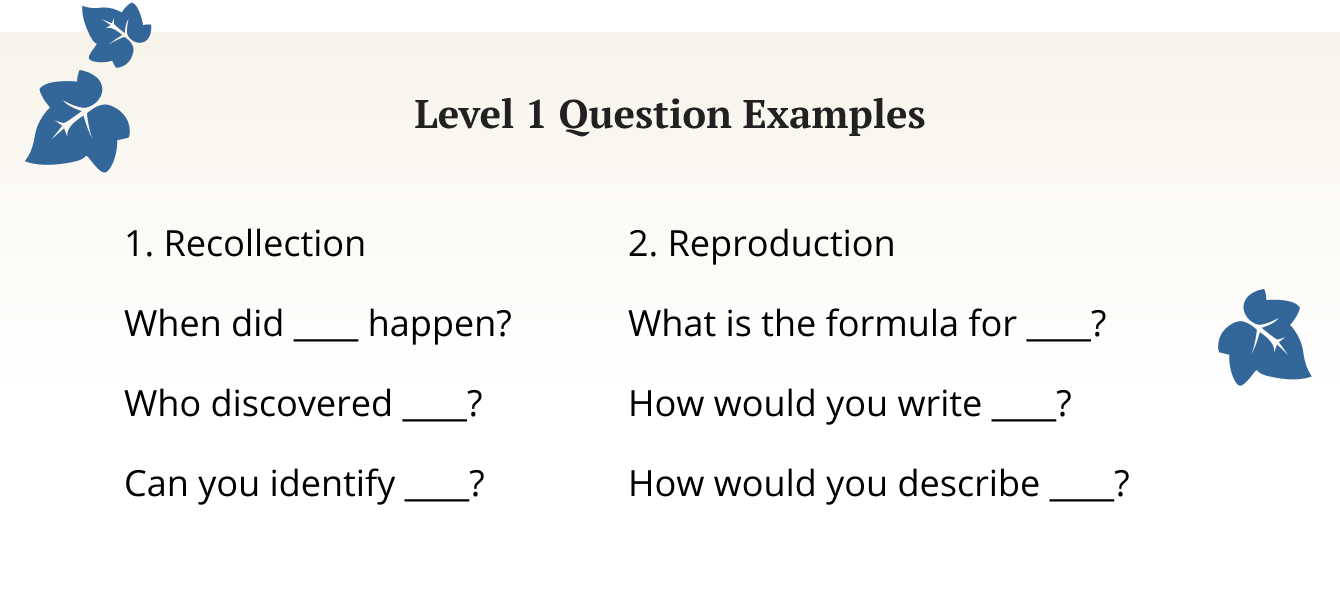
The key idea of this level is that questions and activities should be basic and do not require extended thinking levels.
At the application layer, you can use quizzes, ask your students to outline the key points of a previous lesson, recite a chapter of a book, etc.
Level 2: Knowledge Application
The level 2 demands students to define the best way to solve a problem properly. They should apply the information they learned to solve a task.
As on the first level, you may ask questions and create exercises to help students develop the concept of understanding and skills:
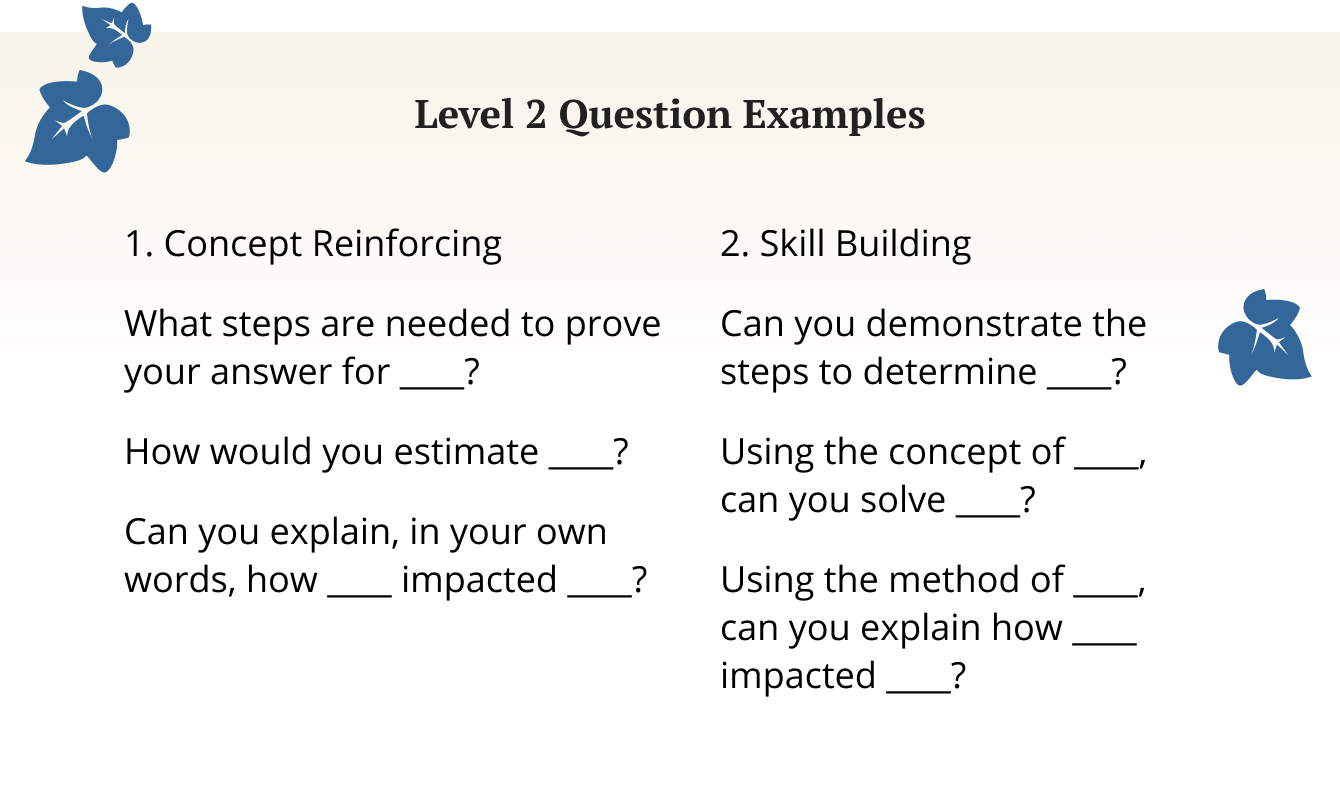
This level requires deeper thinking than the previous one. Using the questions above, you can ask your pupils to write a blog, analyze and review texts, create mind maps showing the relations between concepts, complete multi-step calculations, and so on.
Level 3: Strategic Thinking
Level 3 of Depth of Knowledge suggests student face scenarios and problems more complicated and abstract than in level 2.
For example, you may assign students to write an essay on a particular topic. They can suggest unique directions and reach contradictory conclusions.
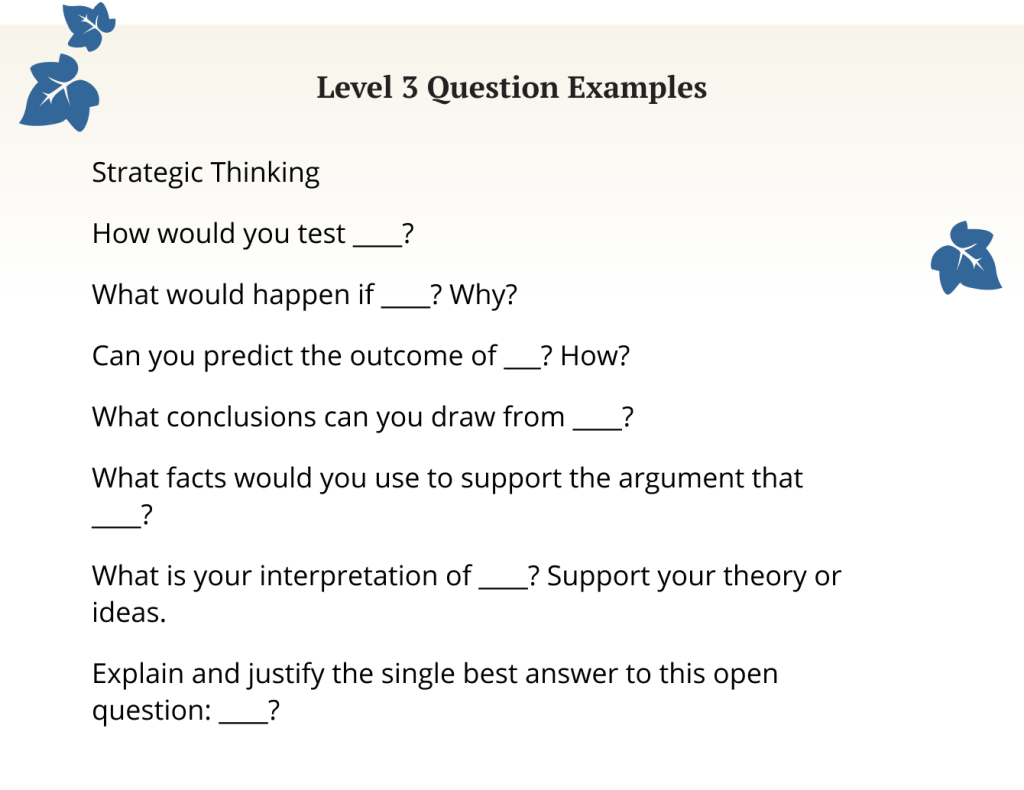
The questions in the picture above are aimed to provoke independent thinking and students’ ability to link concepts.
To apply this strategy to practice, you may suggest your students write an essay, develop a persuasive speech, participate in in-class debates.
Level 4: Extended Critical Thinking
You may be wondering what “extended critical thinking” means. Level 4 involves lots of challenges for students that linked to real-world issues. Students have to develop their ideas and solutions and be able to address the counterpoints.
You should ask them open-ended questions:

At level 4, you can ask students to prepare a cross-subject research project, debate a controversial issue, etc.
Formative and Summative Assessments
These two types of tests are aimed to assess student understanding of the subject. Assessments motivate students to study and allow teachers to identify gaps in the class’s knowledge. Want to know what’s the difference? Check the table below:
As you can see, a formative assessment gives you a clear vision of the learning process, while summative assessment shows its outcomes. If you want to find out more about these assessments, read “The difference between formative and summative assessment” article.
Active Learning
An active learning strategy is a technique that involves students’ active participation in daily classes. According to James Ballencia, an active learning advocate, both teachers and students benefit from using this strategy in the class.
You can use the active learning techniques from our list below to help your students become more creative and engaged in the learning process:
- Reciprocal questioning (ReQuest)
Reciprocal questioning is a strategy that allows you to involve students in the open dialogue. Implementing this strategy, you help them to increase the topic comprehension and develop critical thinking skills.
For example, after reading a chapter of the book, you may divide the class into small groups and ask your students to prepare questions for others.
Such discussions can be beneficial for the test preparation, introducing a new topic or a detailed discussion of the lesson material.
- The pause strategy
This strategy is easy-to-use but yet effective. To apply it, break a lesson into brief 2-3 minutes pauses to allow students discussing the key issues they’ve just learned. Encourage them to ask questions and solving problems related to the lecture subject.
According to R. Bachhel and R. G.Thaman’s study “Effective Use of Pause Procedure to Enhance Student Engagement and Learning,” using pauses during the lecture increases students’ attention and learning outcomes.
- The muddiest point strategy
The key feature of this strategy is to note the most unclear points of a lecture or homework assignment. Students need to range their knowledge of a topic. In fact, they identify concepts for further studies.
A teacher, receiving such feedback, is able to correct the schedule to discuss the complicated issues again.
- The devil’s advocate technique
The idea of being “the devil’s advocate” is in that you ask your students to defend the opposite sides of the issue you discuss during the lesson.
The advantage of this technique is that it’s applicable for all study levels and almost all subjects. It also stimulates critical thinking skills and helps to engage students.
- The peer teaching strategy
Peer instruction is another active learning strategy that allows you to encompass various scenarios for your students. For example, you can assign students to read texts in pairs, play roles, instruct other students as a tutor.
Such a strategy boosts soft skills like accountability, communications, group processing, etc. Below we will discuss it in detail.
Differentiated Instruction
Differentiated instruction (DI) strategy involves active teacher’s reactions to the various learning styles and adjusting the curriculum content.
Unfortunately, educators do not always have enough time to properly plan a lesson that uses these strategies to suit all students. However, the solutions described below are easy to use:
- Learning stations
Learning stations mean separated sections in the class through which students rotate. You can easily combine this technique with a flexible seating option. Each learning section must use a particular method related to a certain learning style.
For example, you can use video, artwork, reading, and listening stations.
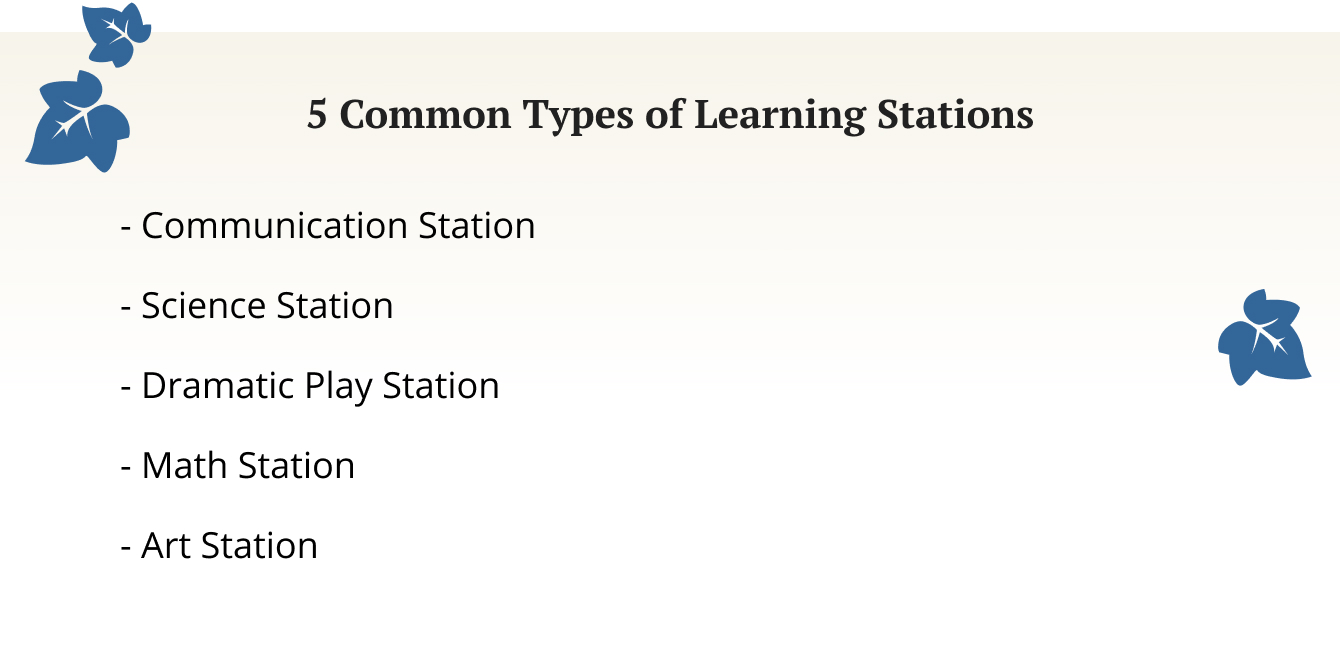
- Task cards
This is another simple DI technique that will be useful for group activities. You can assign students to complete tasks on the cards solo, in small or large groups.
To create cards, identify topics and tasks you want students to tackle. Then print and laminate them. You can do it yourself, buy pre-made cards, or use the Teachers Pay Teachers website. The final step is to set up a learning station and ask your students to complete the tasks on cards.
- Interview your students
The best way to identify the most common learning styles in the class is to ask your students. Interviewing students will help you to adjust the types of content that fits your class’s needs. You can ask them to fill a Google Form or ask students directly about their preferred types of lessons, in-class activities, projects, etc.
Don’t forget to track the results and identify students whose preferences are different.
- Think-Pair-Share Strategy
This simple strategy allows students to learn the lesson content in small or large groups and individually.
Here’s how it works:
- Ask a student to prepare an answer to a specific question on a given topic.
- Students in pairs discuss their findings.
- Each pair shares their results and discusses findings with the rest of the class.
Such a differentiation strategy helps you meet various student learning styles.
- Journaling
You can use journaling or blogging as a study tool. Students reflect on the topics that were given on the lecture, and doing this helps them to process the information.
You can use journaling to summarize lesson outcomes, answer questions, develop new concepts, etc. You can go a bit creative and suggest students run a blog dedicated to your subject and ask them to comment on each other’s entries. Blogging will help them to put their thoughts in a logical order while effectively processing the content.
Personalized Learning
Personalized learning (PL) is an important part of the study process. It aims to build a unique experience that suits the abilities of each student.
Personalized learning teaches students the essential skills that will be useful in the future: goal-setting, self-assessment, and self-advocacy.
According to the research, conducted by the Bill & Melinda Gates Foundation, personalized learning helps students to improve their test scores and overall performance.
Another benefit of a PL is that students with special needs are able to study without stigma. PL allows students to get all the information they need and fill in the knowledge gaps.
There are many other classroom teaching strategies you can use in your daily practice. As a teacher, you can pick up one of those mentioned above, seek for something new, or create your own strategy.

👩🎓 Student-focused teaching strategies
Student-focused teaching strategies address various student learning styles, interests, cultural backgrounds, and the special needs of an individual or a group. These strategies involve different educational methods we’re going to discuss in this article. Want to know how to adjust your subject curriculum to help your students achieve their educational goals?
Keep reading!
Gamification strategy
Every child (and even adult) loves to play games. The gamification strategy involves a combination of the game and learning. Among its advantages is that gamification can be used in almost all subjects: from languages to math.
You might have seen apps like Duolingo that helps people from all over the world learn over 30 languages just using their smartphone. Another great example is Microsoft’s game Minecraft that can be used in teaching students coding, math literacy, etc.
But gamification is not only about online games or tools. You can add a little game to your lessons. Here’s how:
- Structure the information you’re going to gamify. Gamification will be beneficial only when you set up clear rules and explain your expectations.
- Make students’ progress visible. Students need to see where do they go, how far they’ve come, and what they’re going to achieve. In another case, they might get frustrated.
- Don’t forget about the manual. Create an instruction where you will explain the game, its rules, and the scoring system.
If you need any inspiration on how to use games in your classroom, check the article at TeacherThought “12 Examples Of Gamification In The Classroom”
Convergent and divergent thinking

Convergent and divergent thinking were originated in the works of an American psychologist JP Guilford. He named these terms from problem-solving processes they illustrate:
- Convergent thinking describes a thinking process that starts with pieces converging around a result. This type of thinking corresponds to levels 1 and 2 of Webb’s Depth of Knowledge. It doesn’t require creativity from students. Example: asking students to complete the test where you set a question with multiple answer options.
- Divergent thinking stimulates students to use their critical thinking skills to solve a problem. For example, writing an essay with a given prompt requires divergent thinking.
If you’re wondering how to use convergent and divergent thinking strategy, check out tips below:
- Focus on the first words of the question. Here’s the thing: the way you start your question determines the response you’ll get. Convergent questions begin with words “When,” “Who,” “What,” or “Where.” On the opposite side, a divergent question starts with phrases “What might,” “How could,” “Suppose.”
- Ask convergent questions first. When you write a few convergent questions, you will be able to combine them into a divergent question. For example, a student can answer “How could” divergent questions after they show understanding the issue solving “Who” and “What” convergent questions.
- Encourage students’ search for answers. Answers to convergent questions can be found through flipping a textbook, online sources, etc. At the same time, divergent questions require critical thinking skills. A combination of these methods will give the best result.
Project-based learning
Project-based learning (PBL) strategy can be a great contribution to your subject teaching. First, your students can immense to a real-life problem and develop solutions that would be useful in the future. Second, this strategy can be used for group work. Third, its implementation will vary from class to class—depending on students’ abilities, learning styles, class size, etc. PBL strategy leaves a lot of space for various tasks and projects, as well as for differentiated learning.
Let’s analyze the strengths and weaknesses of PBL.
Advantages of project-based learning strategy:
- Higher student engagement. This strategy requires students to actively participate in their learning. PBL tasks are based on real-world issues, and students’ findings are relevant to their future life and career.
- Increased knowledge retention. A study shows that students who work on PBL assessments show better knowledge retention in various subjects: from arts to science.
- Critical thinking development. PBL assignments require students to use their problem-solving skills while tackling the task. As a result, they improve these skills and can use them in off-school life in comparison to traditional learning.
- An opportunity to use EdTech. PBL gives students the opportunity to use various online sources and educational technologies.
Disadvantages of project-based learning strategy:
- Subjective grading. Standardized grading measurements are not applicable to PBL tasks. As a teacher, you will subjectively assess these tasks. That’s why this teaching strategy shouldn’t play a significant role in students’ grades.
- Questionable implementation in some subjects. Some subjects, for example, math, will work better with other teaching strategies than PBL. For example, students will better understand mathematical operation by running through exercises than the PBL context.
Check the article by BookWidgets to find out what project-based learning ideas might fit for your students.
Inquiry-based learning
Inquiry-based learning (IBL) sets as a priority student’s ideas, questions, and analyses. This strategy can be implemented through various learning activities, such as:
- Group projects
- Case studies
- Fieldwork
- Research projects, etc.
An Association for Psychological Science published a study proving that students, who use IBL, are able to absorb information from both the curriculum content and activities.
You can use one or all of IBL types:
- Open inquiry that allows students to proceed with original questions. Scholars answer them using their own methods.
- Guided inquiry requires students to work on an open question to develop investigation methods.
- Confirmation inquiry means a strategy when a teacher gives a question and provides students with ways to solve it.
- Structured inquiry: a teacher asks students to find out a solution for an open question and gives them an investigation method.
If you need more ideas on how to effectively use inquiry-based learning in your class, check the article from Edutopia, or join to the EdX free course dedicated to this strategy.
Problem-based learning

This is another student-oriented teaching strategy that requires students to solve open-ended issues. Like other strategies, it has both advantages and disadvantages.
Keep reading to find out more about them!
Pros of problem-based learning
- Long-term knowledge retention. Here’s the deal: once you find a solution to a problem, you will be able to recall the information you got easily. The problem-based learning strategy strengthens students’ understanding of the topic. The strategy is useful for both individual and group work.
- Various instruction types. Another great benefit of problem-based learning is that you can use it to address various learning styles and needs of your students. For example, you can ask to solve real-life problems, assign students to work in small or large groups, ask students to tackle an issue using a wide range of content and tools.
- Increased engagement. The problem-based assignments can be a great break from routine lectures and common tasks. According to the Association for the Study of Medical Education, courses that offer a problem-based approach attract more students while increasing their attendance and engagement. However, you need to understand that overloading the curriculum can have the opposite effect.
- Transferable skills development. We’re talking about skills that students can bring to their off-school life and real-world scenarios. For example, when students are engaged in a group dispute, they also can use negotiation and communication skills in their lives and career.
Cons of problem-based learning
- Lack of knowledge on tests. While dedicating too much time to problem-based assignments, students may miss vital knowledge they need to achieve high scores on standardized tests. The reason is that tests are using a fact-based approach.
- Students may not be ready for such activities. Some students might feel disengages as they are not mature enough for problem-based learning, lack of prerequisite information, or don’t have enough skills and information.
- Lack of time. Problem-based learning requires a lot of time for both teacher and student. On the one side, students may be overloaded with assignments on other subjects. On the other hand, a teacher has to assess the quality of completed tasks, group and individual performance, team communication. All this can be time-consuming to grade each student.
Learn more about problem-based learning strategies from the InformED’s article “10 Tips For Effective Problem-Based Learning: The Ultimate Instructional Solution.”
Experiential learning

Here’s another student-centered approach to teaching that allows teachers to address a wide range of learning styles in the class. This strategy describes the learning process as acquiring knowledge through experience.
This approach allows students to stay focused on the topic, learn faster, and keep them engaged emotionally.
Find out more about how to get started with experiential learning from Edutopia’s article.
Peer teaching
Peer teaching is an effective strategy that helps students to develop critical thinking, self-esteem, and interpersonal skills. Let’s take a closer look at its benefits and limitations:
Benefits of peer teaching
- Higher literacy scores. According to the studies, students who read and discuss class reading content with their peers score higher on tests and exams than those who don’t.
- Critical thinking skills development. Students who are assigned to work in pairs or small groups become active learners since they discuss and rationalize the topic contents in their words. As a result, these students perform better on tests.
- Interpersonal skills development. Peer teaching gives a wonderful opportunity to both tutors and tutees. The first ones improve self-esteem skills by providing feedback and explaining the subject. The second learn to ask questions and build communication skills.
- Adaptability. Peer teaching can be used for a range of subjects: from languages to math. You can even involve older peers in this process.
Limitations of peer tutoring
- Lack of student expertise. Even if you share tutoring tips and guides, your students won’t become experts or gain teaching skills. You have to understand that there still a lot of room left for ineffective feedback, lack of peer support, or redundant criticism.
- Student skepticism. Pairing students together can be a daunting task. Tutees can reject putting any effort into the assigned tasks. Or peers may have tense relationships. Such situations negatively reflect on content coverage.
- Low applicability in the schools. Peer tutoring works effectively in post-secondary institutions because adults are able to collaborate without a professor’s supervision effectively. However, in elementary and high schools, this strategy can be ineffective.
Find out more about how on to prepare students in your classroom for peer teaching from Catherine Birch’s article.
Cooperative learning

Perhaps, cooperative learning is one of the most common teaching strategies. It encourages students to work together and allows the teacher to apply small-group teaching.
To successfully implement a cooperative learning strategy in your classroom, you should know its five essential principles:
- Positive interrelations. Students should understand that each member of their study group is essential, and their contribution to individual and group success is valuable.
- Empowering interaction. Students should support each other by offering help, providing feedback, and sharing resources.
- Responsibility. Students are responsible for their roles in reaching the team’s learning goals.
- Soft skills teaching. A teacher should provide lessons and assign various tasks related to teamwork to help students develop interpersonal communication skills.
- Group strategies. Students in groups should use strategies to achieve their learning goals
Depending on the cooperative learning strategy type you will use in the classroom, these principles will work differently. Here are the three most common types of cooperative learning:
- Formal cooperative learning. Formal cooperative learning strategy focuses on grouping students to tackle an ongoing exercise that lasts a determined time—from couple days to a few weeks. A teacher’s role is to design the goals for each group. You should carefully select students who work well while keeping in mind their strengths to achieve learning objectives.
- Informal cooperative learning. This strategy requires student groups to work to meet a straightforward shared learning goal within a few minutes. A teacher should clearly instruct students and assign a task that requires the written or spoken answer.
- Cooperative base group strategy. This type of cooperative learning strategy involves group work that lasts longer than the previous two. Students groups should achieve learning goals over the study year.
A teacher should create small groups of 3-4 students, schedule meetings, and provide a detailed agenda for them.
Interdisciplinary teaching
An interdisciplinary teaching strategy empowers students to develop creative, communication, and critical thinking skills. Students learn to pick up information from various academic subjects and use them to solve problems.
The key benefits of interdisciplinary teaching include:
- Better critical thinking skills. Students improve their analytical skills when using different approaches from various disciplines.
- Improved bias recognition. The interdisciplinary teaching approach demand to tackle an issue that requires using information from various sources. To solve the task, students challenge their thoughts and ideas to recognize bias.
- Preparation for real-life problems. Almost all issues in adult life demand knowledge and skills from different disciplines. The interdisciplinary approach teaches students to apply the knowledge they get to tackle both inside and outside problems.
Still wondering how to implement an interdisciplinary approach in your classroom? Check a couple of sample activities below (and don’t forget that you’ll need to collaborate with other teachers!):
- Analysis of the news. You can use the reports on various topics and ask students to tackle the related issues using the skills and knowledge they’ve gained in other subjects.
- Climate change. The weather and climate are not about meteorology or ecology. You can ask students to solve related problems using the information they learned in Physics, Biology, Social sciences.
Check this TEDx video to find out more about the importance of an interdisciplinary teaching approach:
Service learning
A service-learning strategy is a combination of academic goals and community service projects. Students learn course curriculum content while completing service projects aimed at solving various community issues.
Service-learning strategy can be beneficially combined with an interdisciplinary approach as they have to solve community problems using the knowledge they received from different academic subjects. A strategy empowers students to contribute to their community and get hands-on study experience. Among other advantages of service learning are improved empathy and communication skills, boosted awareness of local and international issues, and reduced risk of bad behavior in the class.
Check the article “7 Creative Ideas for Bringing Service Learning to Your Classroom” to get inspiration for your own service-learning projects.
Media literacy
Media literacy is essential for modern students because they face different media influencers daily: from TV to YouTube bloggers. Students should understand and interpret the information they consume.
Media literacy strategy can be implemented in the teaching process of almost any subject. Here are some benefits that you should keep in mind when you are planning such activities:
- Understanding the point of view. Teaching students media literacy, you help them recognize the point of view in a given media piece. Students learn to examine and contextualize the information they get from a movie, news, or Instagram post.
- Connection to other subjects. Media literacy teaching can be a great addition to the interdisciplinary teaching strategy. For example, in language classes, you can ask students to analyze movie characters.
- Improved critical thinking skills. Evaluation of media empowers students to analyze how accurate, clear, and truthful the message is.
- Learning to create various products. Students can “learn by doing” when they work on creating different products: logos, printed ads, TV scripts, newspapers, etc.
- Connecting study content with student interests. You can increase the subject content by linking it with popular media. For example, you can assign them to examine plot devices of a trendy movie.
The guide from Canva can be very beneficial when you are looking for ideas to use in your teaching.
Blended learning
This is the last but not the least teaching strategy in our list. Blended learning is a mix of online and traditional classroom education.
This student-oriented teaching strategy allows your students to study at their own pace. Here’s an example: students who struggle with the lesson material can get more teacher’s attention while those who show good results and understanding of the content, and are eager to learn more, get new challenges.
There are numerous ways to implement a blended learning strategy in your classroom. Some of them require using a tablet and creating learning stations while others suggest teachers to put a part of curriculum content online.
For example, you might record online mini-lessons to free some time for in-class group work, use online labs, etc.
You can use and combine all the teaching strategies we mentioned above or think about the development of your own approach. However, you should always keep in mind that people differ from each other and your job as a teacher to meet your students learning styles and goals.
🔗 20 Best Online Tools and Resources for Teachers
Now, let’s talk about tools, resources, and technologies you can use in your classroom for various purposes: from paperwork automation to teaching. Just check our list below!
1. ReadWriteThink
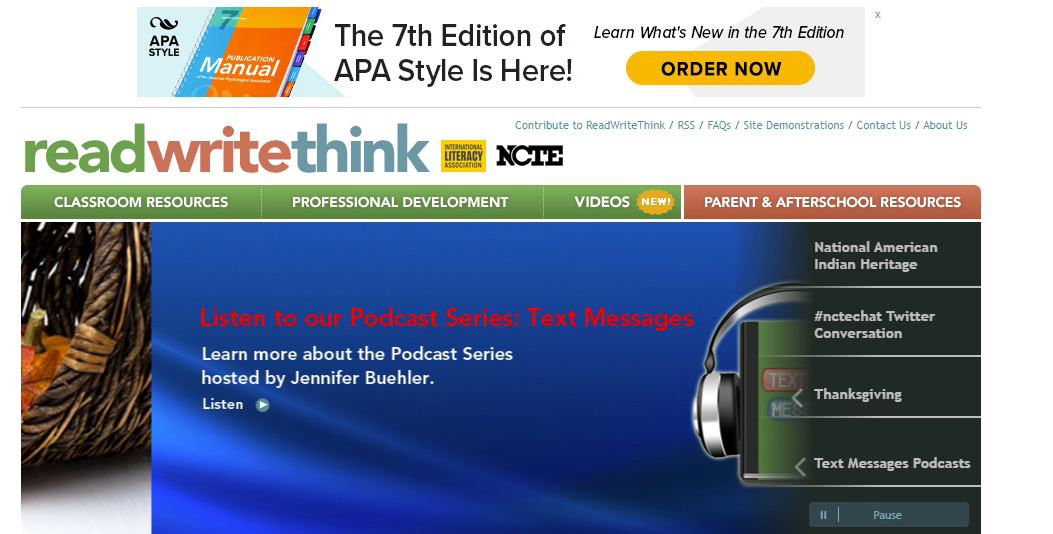
This online resource will be useful for both kindergarten and school teachers. Here you will find lessons, various activities, apps for students, and more. The website contains plenty of unit and lesson plans divided by grade level, subject, and learning goal.
Cost: Free
2. Flocabulary
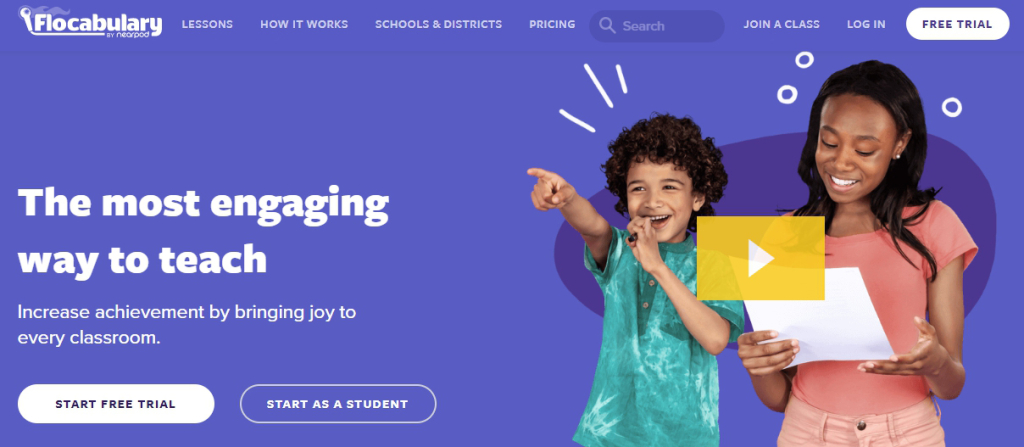
The tool is designed to boost students’ engagement. Lessons are delivered through a media that your pupils will love. Flocabulary aimed to help students build a vocabulary for various lessons: Math, Science, Language Arts, Social Science, etc.
Cost: Free trial, from $10/month
3. Pixton
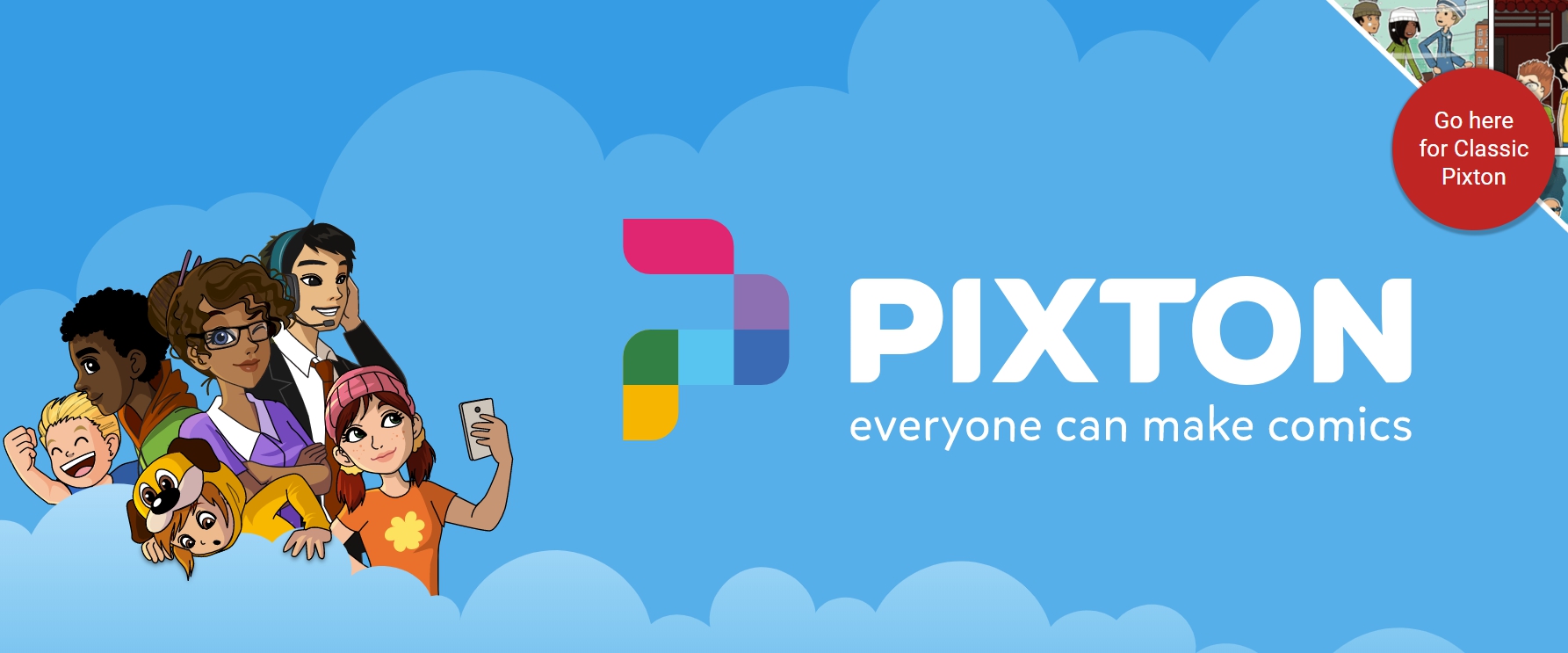
Almost all kids love comics. Why don’t you try this tool to add some fun to your subject? This online tool can become a great instrument in explaining to students various topics in different subjects: from Literature to Science and Tech. Suggested lesson plans are also available.
Cost: Starts at $1/student
4. Epic!

Epic is an online library with a rich book selection that will be useful for your class. It allows you to assign a certain topic for reading and track students’ progress. The apps work great on both iOS and Android devices.
Cost: Free for teachers & librarians
5. BrainPOP Jr.

Another colorful interactive tool for elementary students. There are thousands of videos, games, printables, and quizzes to help your pupils study. Here you will find materials for Language Arts, Math, Science, Health, Social Studies, and even coding.
Cost: Starts from $175
6. News-O-Matic

Let your students feel like reporters. News-O-Matic is an exciting tool that gives your students an opportunity to go beyond the borders and gain knowledge along with developing critical thinking and writing skills. The app provides a daily dose of five articles on different topics to discuss in the classroom. Also, you can assign your students to write their own content on a particular topic.
Cost: Starts from $3.99/month
7. Prodigy
This is a free online tool that gives teachers literally endless opportunities in teaching math for 1-8 grades. You can engage students through games, use it as a part of your blended learning strategy, monitor students’ performance, create plans and assignments, and use many other options. Parents also can track and support their child’s performance.
Cost: Free
8. PhET Interactive simulations

Nobel Laureate Carl Wieman founded this online project is founded by at the University of Colorado Boulder in 2002. The tool provides various simulations for Physics, Chemistry, Maths, Science, and Biology to demonstrate students how a concept works. All the simulations are interactive and can be used both in-class and for homework projects.
Even though it might seem a little bit outdated, it is still worth your attention. For example, your students will easily understand the static electricity concept with the John Travoltage simulation.
Cost: Free
9. Desmos

If you’re still wondering how to explain to your students the graph functions, equations, or other math operations, try Desmos. This is a free online tool that gives your students a visual perception of the concepts they learn. Students can go more creative and even create fun arts using math formulas and graphs.
The tool is available on desktop and mobile devices.
Cost: Free
10. Virtual Nerd
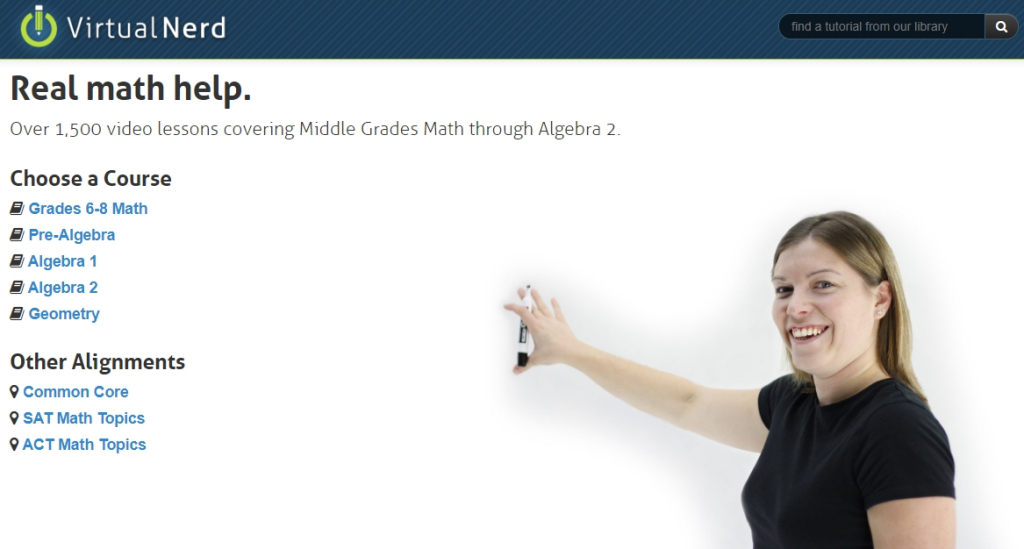
Virtual Nerd can become your assistant in blended math teaching. The website contains 1,500 video lessons that cover high school math topics and will be helpful for the ACT and SAT preparation. All videos are free and cover a wide range of topics.
Cost: Free
11. CanFigureIt Geometry
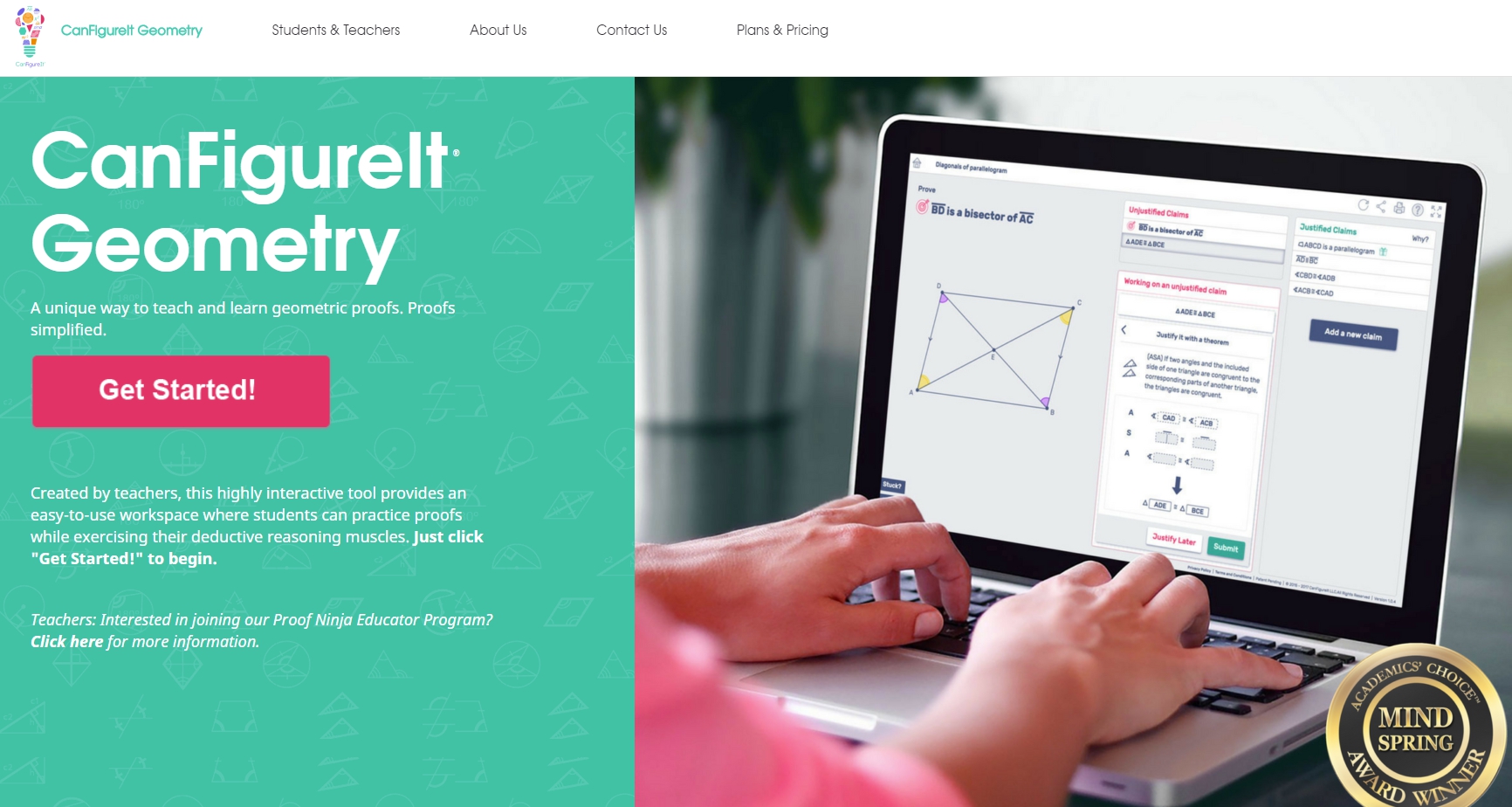
The tool is aimed to teach your students geometry proofs. The online app is an interactive instrument that allows students to exercise proof. Teachers have access to student performance reports and are able to assign personal tasks.
Cost: Starts from $150 per year/class subscription
12. Minecraft
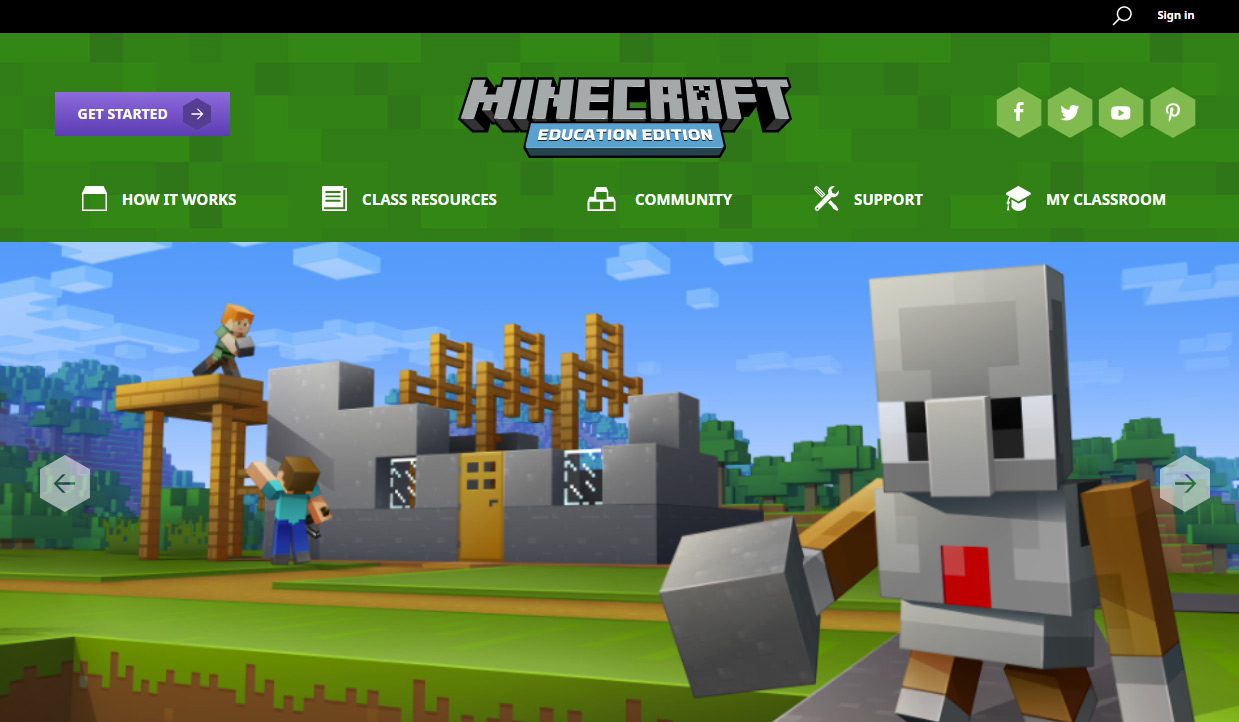
Yes. This popular game from Microsoft can be used in your classroom! Minecraft is an outstanding tool to teach your students Computer Science and Math. Your students will love it! The website provides student video tutorials and videos for teachers.
Cost: $5 for a one year license
13. Google Docs and Forms

Yes, you may say that this is obvious. However, Google apps are still useful for you and your students. First, you’re able to assess written tasks online, leaving comments to student’s work and track their performance. It saves lots of time. Second, Google forms work well for small tests, quizzes, and in-class surveys.
Cost: Free
14. Google Arts and Culture
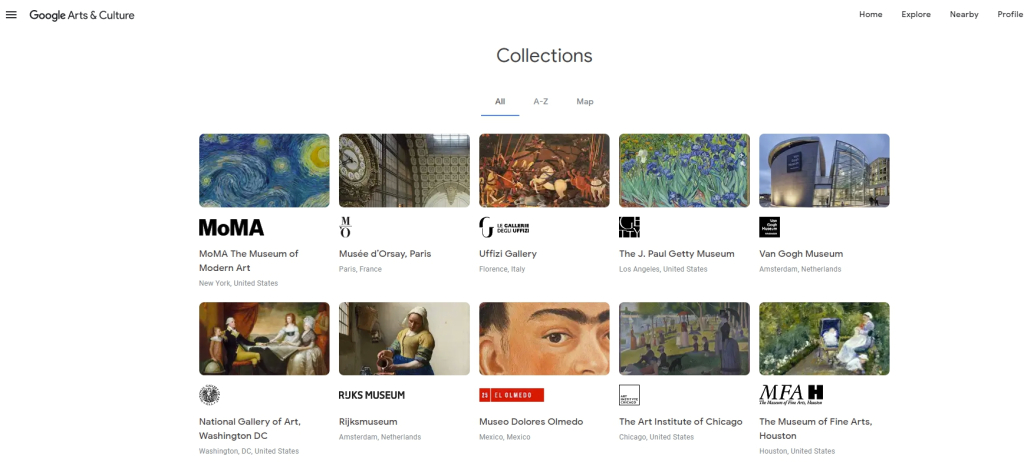
Another great app by Google that will be useful for Arts, History, and Geography teachers. Your students can visit museums and walk the streets of famous cities, learn about historical figures and events, discover art masterpieces. This can be a great alternative for a field trip, especially when your school is far from museums.
Cost: free
15. Class Monster Pro
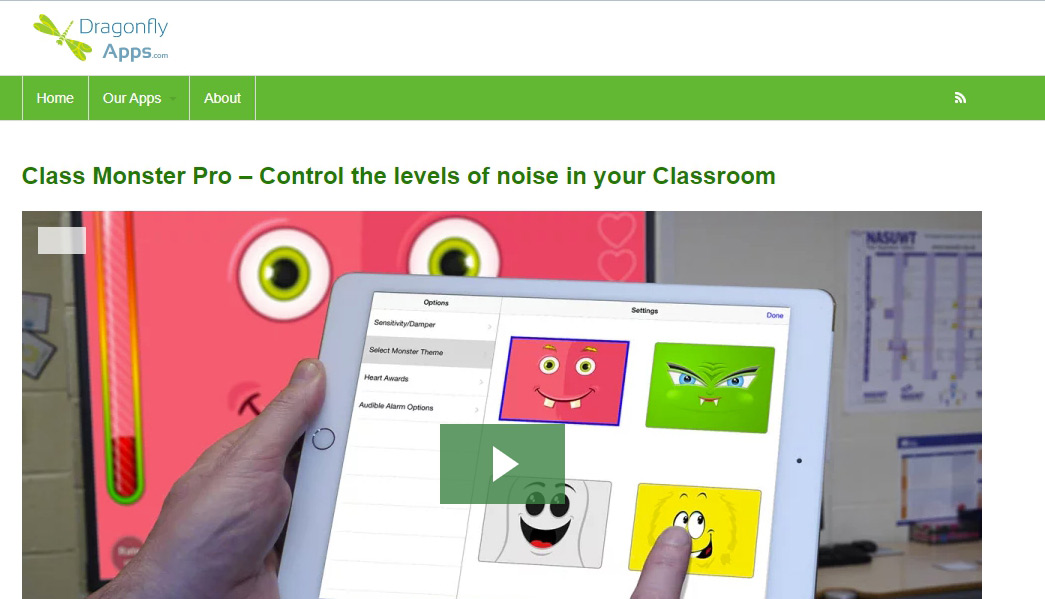
How many times you asked or even yelled: “Class, quiet!”? The high noise levels in class significantly worse the perception of information. This app will measure it and notify you if the background noise level gets too high. Your students will like the app’s monster and won’t upset it.
Cost: $3.99
16. ChartBlocks
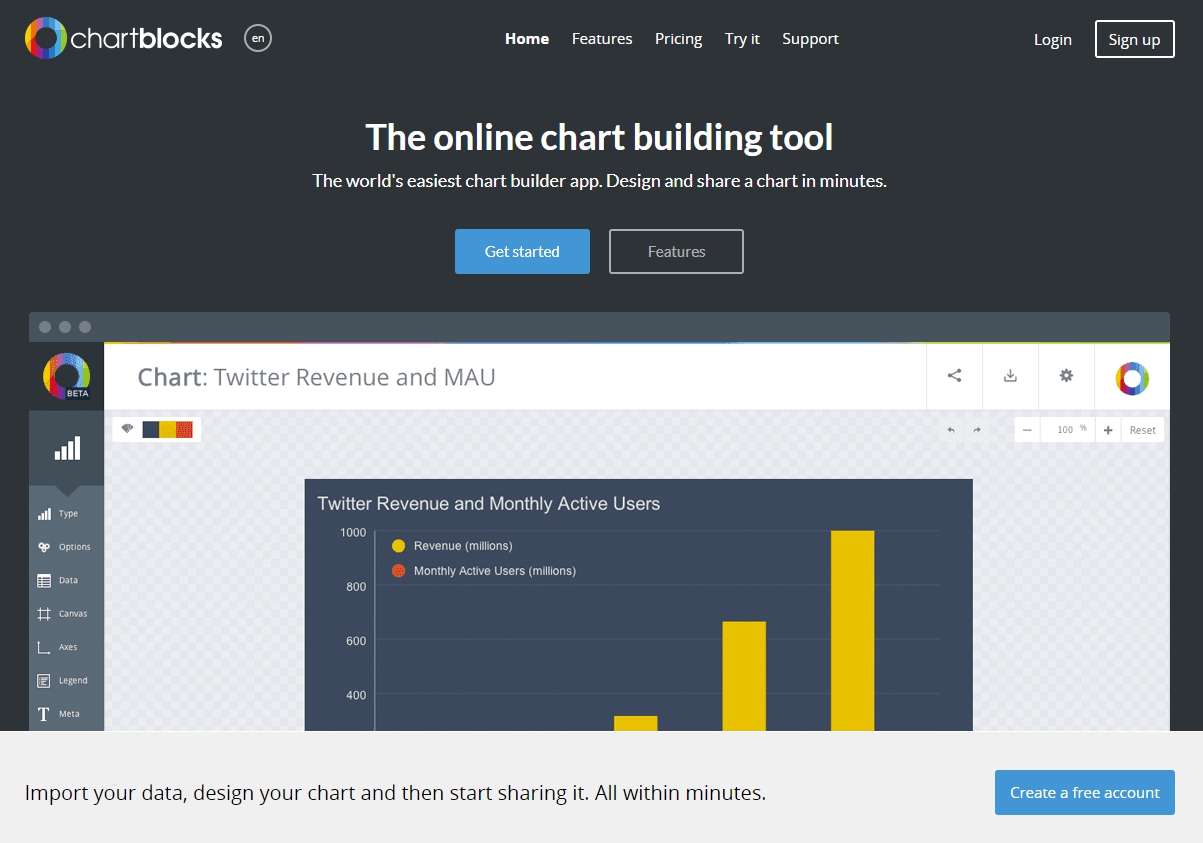
You and your students can draw charts using this online tool. Input the data, add labels, set design, and visualize lesson content. The personal pricing plan is free and supports up to 50 charts. The app allows you to export charts in PDF, EPS, SVG, and PNG format.
Cost: Starts from $0
17. National Library of Virtual Manipulatives
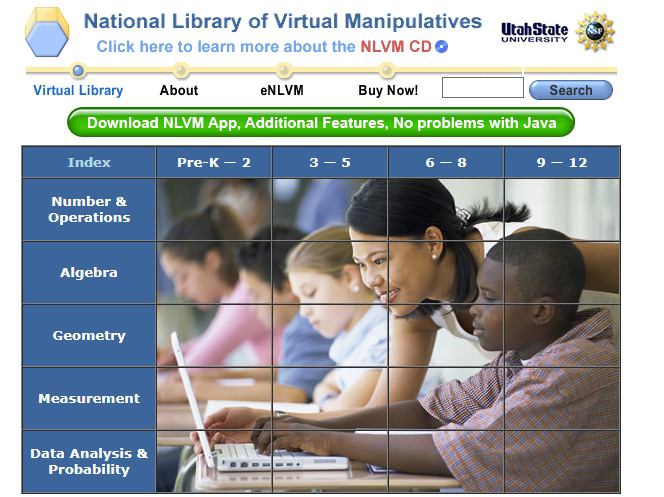
The free online interactive tools that help you visualize and explain different concepts: from Math to Economics. It may seem a little outdated and requires Java installed. However, you can always purchase an offline version of simulators at Matti Math.
Cost: Free
18. MindMup
The app will be useful for both in-class and off-class brainstorming sessions. It allows collaborating students with each other. MindMup is also compatible with Google Docs.
Cost: free
19. KQED Learn
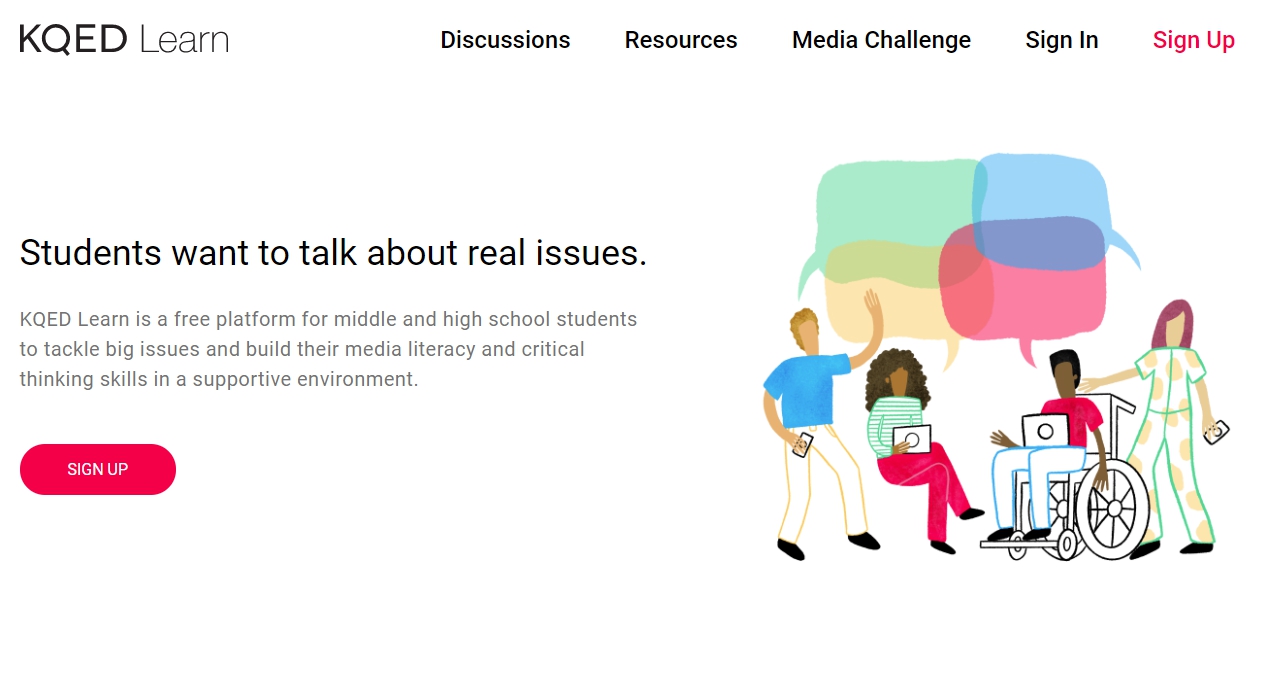
Implement inquiry-based learning in your teaching strategy with this website. Here’s how you can use it: engage your students to participate in discussions around various controversial topics. They are able to discuss it with their peers across the country and share their visions through a variety of formats: texts, infographics, videos, and audios.
Cost: Free
20. Socrative
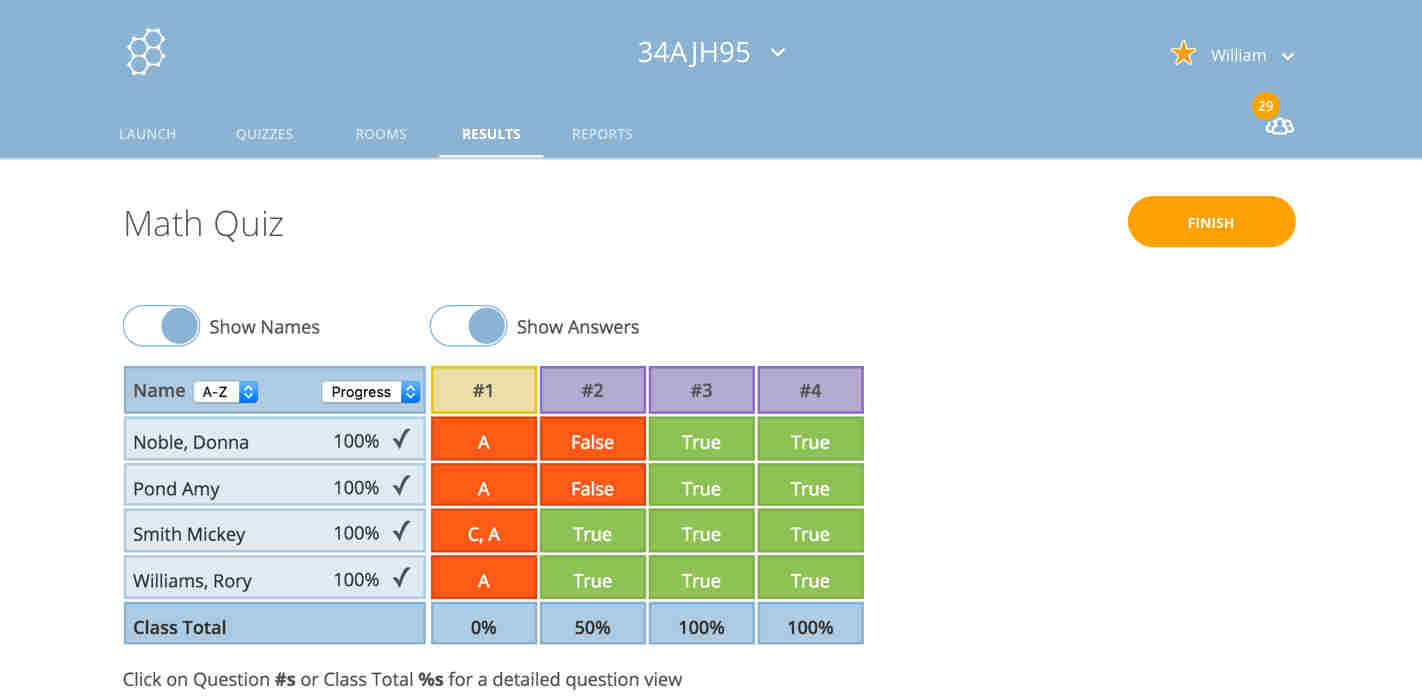
Let your tests become digital. Socrative is an easy-to-use tool that provides various options for student assessment. Quizzes and quick questions will save you time and reduce papers on your desk. You can track students’ results and responses (they are graded automatically!).
Cost: Free
Now, you know the essentials of the teaching profession. Bookmark our blog for more useful tips and strategies for teachers and students!



![14 Free Language Learning Apps [+Bonus: 5 Free Websites]](https://ivypanda.com/blog/wp-content/uploads/2019/07/indoor-photo-of-satisfied-teenage-girl-texts-on-cellular-reads-interesting-article-online-wears-casual-outfit-creats-new-publication-on-own-web-page-isolated-over-brown-wall-with-free-space-309x208.jpg)
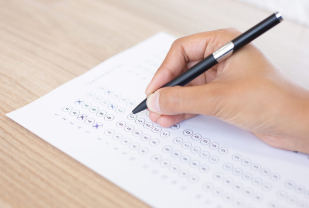



This is a very Valuable resource. I will post it on TeachersBrigade.org website.
Thank you for sharing!
Cindy OMealy,
Teachers Brigade Executive Director
Thank you for your kind words and for sharing, Cindy!